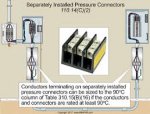Electriman
Senior Member
- Location
- TX
Greetings,
The cable ampacity is greatly reduced when the cable is running in duct bank i.e. a 750 Kcmil per table 310.15 is 535 at 95 degree but when it is in a ductbank next to 20 other cables per calculation it gets near 200 A.
So if a large feeder i.e. 4500 that has above ground and underground portion then the required number of cable for above ground and under ground is different for instance in this example for AG 9 run vs UG 23. Running 23 cables above ground is difficult and not economical.
I am trying to find solutions. I was thinking to use cable tap box or using trench instead of ductbank.
I was hoping I can get some advice in this case. Is there any body experience similar thing and what they have done?
The cable ampacity is greatly reduced when the cable is running in duct bank i.e. a 750 Kcmil per table 310.15 is 535 at 95 degree but when it is in a ductbank next to 20 other cables per calculation it gets near 200 A.
So if a large feeder i.e. 4500 that has above ground and underground portion then the required number of cable for above ground and under ground is different for instance in this example for AG 9 run vs UG 23. Running 23 cables above ground is difficult and not economical.
I am trying to find solutions. I was thinking to use cable tap box or using trench instead of ductbank.
I was hoping I can get some advice in this case. Is there any body experience similar thing and what they have done?



